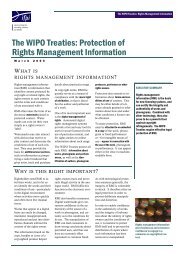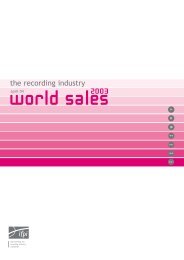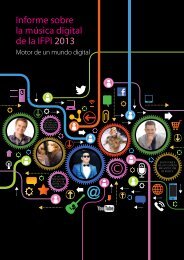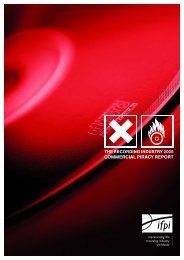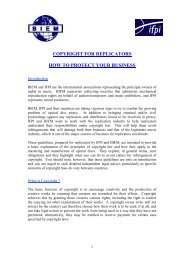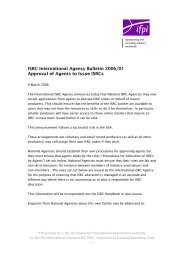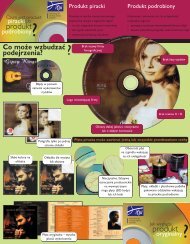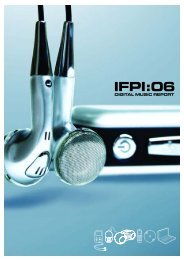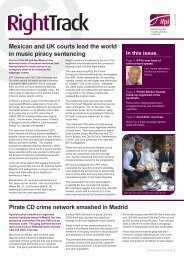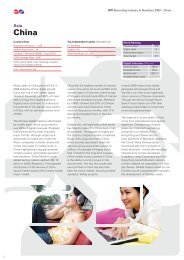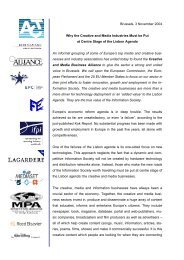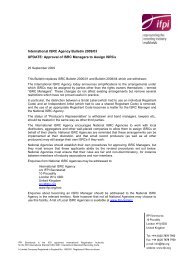The WIPO Treaties: Technological Measures - IFPI
The WIPO Treaties: Technological Measures - IFPI
The WIPO Treaties: Technological Measures - IFPI
Create successful ePaper yourself
Turn your PDF publications into a flip-book with our unique Google optimized e-Paper software.
<strong>WIPO</strong> <strong>Treaties</strong>: <strong>Technological</strong> Protections<br />
<strong>The</strong> <strong>WIPO</strong> <strong>Treaties</strong>: <strong>Technological</strong> <strong>Measures</strong><br />
M a r c h 2 0 0 3<br />
W HAT ARE TECHNOLOGICAL MEASURES?<br />
With the introduction of legal<br />
protection for technological<br />
measures, the <strong>WIPO</strong> <strong>Treaties</strong><br />
create a unique new way of<br />
protecting copyrighted products<br />
as new digital and internet-based<br />
uses emerge.<br />
<strong>The</strong> treaties recognise that authors<br />
and other rights owners<br />
increasingly rely on technical<br />
means—commonly known as<br />
technological protection measures<br />
or TPMs—such as encryption<br />
and other mechanisms<br />
to control unauthorised<br />
copying, transmission and use<br />
of their products.<br />
TPMs take various forms and<br />
their features are continually<br />
changing, but some major features<br />
remain constant. <strong>The</strong><br />
most basic and most important<br />
kind of TPM is access control<br />
technology. One common<br />
way of controlling access is<br />
encrypting or scrambling the<br />
content. In such case the user<br />
gets the data but must follow<br />
an additional procedure to<br />
make it usable.<br />
Another form of access control<br />
is a procedure that allows access<br />
to a source only with<br />
proof of authorisation, for example,<br />
password protection<br />
for a computer server.<br />
<strong>The</strong> other major type of TPM,<br />
copy or use controls, enable the<br />
rights owner to allow certain<br />
permitted activities but to prevent<br />
illicit activities by a user<br />
who has access to the work.<br />
<strong>The</strong> <strong>WIPO</strong> Copyright Treaty<br />
(WCT) and the <strong>WIPO</strong> Performances<br />
and Phonograms<br />
Treaty (WPPT) require adequate<br />
legal protection and effective<br />
legal remedies against<br />
the circumvention of TPMs<br />
applied to protected works and<br />
phonograms. (WCT Art. 11;<br />
WPPT Art. 18.)<br />
<strong>The</strong>se provisions are formulated<br />
in a broad and neutral<br />
way, oriented more to the desired<br />
result than on how to<br />
achieve it. In implementing<br />
these treaty provisions, however,<br />
governments have recognised<br />
that their laws need to<br />
cover the act of circumvention<br />
itself, as well as the manufacture<br />
and distribution of a range<br />
of circumvention devices, in order<br />
to provide adequate and<br />
effective protection.<br />
EXECUTIVE SUMMARY<br />
<strong>Technological</strong> protection<br />
measures (TPMs) deter piracy,<br />
encourage rights owners<br />
to use new media like the<br />
internet, and provide consumers<br />
a sophisticated new<br />
range of ways of enjoying<br />
music.<br />
<strong>The</strong> <strong>WIPO</strong> <strong>Treaties</strong> require<br />
effective legal protection of<br />
TPMs. Governments have<br />
recognised that this means<br />
protecting against ‘hacking’<br />
and covering a range of circumvention<br />
devices and related<br />
illicit activities.<br />
WHY IS IT IMPORTANT TO PROTECT TPMS?<br />
<strong>Technological</strong> solutions themselves<br />
are not invulnerable.<br />
Technical systems can be<br />
hacked. Unauthorised passwords<br />
and access codes frustrate<br />
access-control software.<br />
And the making and distribution<br />
of circumventing devices<br />
pose a serious danger to the<br />
integrity of any TPM.<br />
As no technological measure<br />
can permanently resist deliberate<br />
attacks, a TPM is only as<br />
good as its legal protection.<br />
Protecting TPMs is important<br />
both for rights owners and consumers.<br />
Of course, TPMs deter<br />
piracy, and encourage rights<br />
owners to use new media like<br />
the internet.<br />
But by allowing a wide range<br />
of listening, copying and transmission<br />
options, TPMs also<br />
permit the development of new<br />
marketing, distribution and<br />
usage models, which open up a<br />
sophisticated new range of<br />
ways of enjoying music.<br />
Consumers will benefit from<br />
these new ways of enjoying<br />
music and other copyrighted<br />
products, but only if TPMs are<br />
meaningfully protected.<br />
TPM protection also benefits<br />
telecommunications and equipment<br />
providers. Internet services<br />
profit from increased traffic<br />
and legitimate electronic<br />
commerce in copyrighted material.<br />
And consumer electronics and<br />
computer producers, which<br />
spend substantial sums developing<br />
new equipment and encryption<br />
technologies to play<br />
protected material, find their<br />
innovation frustrated and their<br />
investment rendered worthless<br />
if TPMs can be neutralised by<br />
hacking.
<strong>WIPO</strong> <strong>Treaties</strong>: <strong>Technological</strong> Protections<br />
Page 2<br />
H OW SHOULD THIS BE IMPLEMENTED?<br />
<strong>WIPO</strong> TREATY TEXT<br />
WCT Art. 11.<br />
Contracting Parties shall provide<br />
adequate legal protection and<br />
effective legal remedies against<br />
the circumvention of effective<br />
technological measures that are<br />
used by authors in connection<br />
with the exercise of their rights<br />
under this Treaty or the Berne<br />
Convention and that restrict acts,<br />
in respect of their works, which<br />
are not authorised by the authors<br />
concerned or permitted by law.<br />
WPPT Art. 18.<br />
Contracting Parties shall provide<br />
adequate legal protection and<br />
effective legal remedies against<br />
the circumvention of effective<br />
technological measures that are<br />
used by performers or producers<br />
of phonograms in connection<br />
with the exercise of their rights<br />
under this Treaty and that<br />
restrict acts, in respect of their<br />
performances or phonograms,<br />
which are not authorised by the<br />
performers or the producers of<br />
phonograms concerned or<br />
permitted by law.<br />
Most countries are finding that<br />
their copyright laws require<br />
some modernising to deal with<br />
TPM protection adequately.<br />
<strong>The</strong>re are several elements that<br />
governments and rights owners<br />
have found crucial to effective<br />
legal protection for TPMs:<br />
•Protection of access and copy<br />
control technologies. <strong>The</strong> treaties<br />
require protection of TPMs (1)<br />
that are used in connection with<br />
the exercise of rights, and (2)<br />
that restrict unauthorised acts.<br />
This only covers TPMs applied<br />
to works protected by copyright<br />
or related rights.<br />
Clearly this protection should<br />
apply to copy and use control<br />
TPMs that directly restrict unauthorised<br />
reproduction, public<br />
communication, or other direct<br />
exercises of the rights owner’s<br />
rights.<br />
Protection likewise should apply<br />
to access-control technologies,<br />
which also meet both tests<br />
of the treaties. Rights owners<br />
use access control, presently the<br />
most popular type of TPM, in<br />
connection with the exercise of<br />
their rights—whether selling<br />
physical copies or disseminating<br />
electronic copies to the public.<br />
Access controls not only prevent<br />
unauthorised use but also<br />
discourage unauthorised reproduction,<br />
distribution and transmission.<br />
• Protection against act of circumvention.<br />
<strong>The</strong> treaties explicitly<br />
require legal protection and effective<br />
remedies against the act<br />
of circumvention of TPMs.<br />
Circumvention is sometimes<br />
called ‘hacking’—manipulating<br />
the technological measure in<br />
some way so as to limit or<br />
eliminate the function it was<br />
designed to perform. <strong>The</strong> US<br />
law implementing the treaties<br />
defined circumvention as<br />
‘avoiding, bypassing, removing,<br />
deactivating, or otherwise impairing’<br />
a technological measure.<br />
• Prohibition of circumventing<br />
devices. Adequate legal protection<br />
and effective legal remedies<br />
cannot stop at prohibiting circumvention<br />
itself. In order to<br />
control widespread hacking and<br />
other circumventing activities,<br />
circumvention devices and<br />
other means designed to facilitate<br />
hacking also must be controlled.<br />
This does not require outlawing<br />
multi-purpose devices like personal<br />
computers as such, simply<br />
because they can be used for a<br />
range of illicit purposes. Governments<br />
have recognised that<br />
devices must be controlled,<br />
however, if they are designed or<br />
adapted to circumvent.<br />
This formulation has been refined<br />
in EU legislation and elsewhere<br />
to include devices that<br />
(1) are primarily designed or produced<br />
for the purpose of circumvention,<br />
(2) have only a limited<br />
commercially significant purpose or<br />
use other than to circumvent; or<br />
(3) are marketed, promoted or<br />
advertised for circumvention<br />
purposes.<br />
•Devices, components and other<br />
means. Circumvention devices<br />
are not always an isolated<br />
‘black box’, such as a pirate decoder.<br />
<strong>The</strong>y can also be one<br />
part of a more complex piece of<br />
equipment, or an intangible<br />
means such as computer software<br />
or access codes, that has<br />
the same function as a standalone<br />
circumvention device.<br />
It is thus important that rules on<br />
circumvention devices apply<br />
equally to parts and components<br />
of devices, software, algorithms<br />
and access information such as<br />
passwords and access codes that<br />
otherwise meet the definition of<br />
an illicit device.<br />
•Manufacture, distribution, offering<br />
to the public, communication of<br />
devices and services. A range of<br />
activities related to circumvention<br />
devices should be covered.<br />
In most cases, treaty implementing<br />
legislation has extended<br />
to all manner of manufacture,<br />
marketing, offering to<br />
the public and distribution of<br />
circumvention devices, as well<br />
as services that assist with such<br />
circumvention.<br />
Not only are the features of<br />
TPMs and devices subject to<br />
continuous change, but the<br />
catalogue of activities that promote<br />
circumvention of TPMs<br />
also will change over time—<br />
requiring a broad definition of<br />
the acts covered by legislation<br />
dealing with circumvention devices<br />
and services.<br />
• Effective remedies. <strong>The</strong> treaties<br />
also explicitly call for effective<br />
legal remedies. This is of<br />
great importance, because action<br />
against hacking and other<br />
circumvention of TPMs must<br />
be sufficiently speedy, efficient<br />
and deterrent to counteract the<br />
otherwise great incentive hackers<br />
and pirates have to break<br />
TPMs and steal content.<br />
Effective legal remedies should<br />
include both criminal law sanctions<br />
and civil law remedies.<br />
Criminal penalties should permit<br />
fines and prison terms in<br />
appropriate cases.<br />
To serve as a deterrent, civil law<br />
should allow fast and efficient<br />
preliminary proceedings, injunctive<br />
relief, payment of damages<br />
including statutory damages,<br />
and the obligation to cooperate<br />
in neutralising harm<br />
already caused.<br />
To get illicit devices out of circulation,<br />
remedies also should<br />
allow tracing, seizure, retention<br />
and destruction of physical devices<br />
and intangible software<br />
and information.<br />
Criminal penalties and civil<br />
remedies should not be any<br />
lower than those available for<br />
copyright infringement.
Page 3<br />
<strong>WIPO</strong> <strong>Treaties</strong>: <strong>Technological</strong> Protections<br />
F REQUENTLY ASKED QUESTIONS (FAQS)<br />
How strong must a technology be<br />
in order to enjoy protection?<br />
A TPM should be protected as<br />
long as, in the ordinary course<br />
of its operation, it effectively<br />
restricts access to or use of the<br />
content in any manner. <strong>The</strong>re<br />
is no threshold standard of<br />
sophistication or security. <strong>The</strong><br />
fact that a TPM has been circumvented,<br />
or the availability<br />
of a circumventing device,<br />
should not affect whether a<br />
device is deemed ‘effective’.<br />
TPMs that have been subjected<br />
to attacks are the ones<br />
that need protection most.<br />
Could someone be held liable for<br />
unknowingly assisting in the circumvention<br />
of a protected TPM?<br />
No. <strong>The</strong> offering and supply<br />
of services and assistance in<br />
the circumvention of TPMs<br />
need only be prohibited if the<br />
activity, viewed subjectively or<br />
objectively, has this purpose.<br />
Will TPMs lead to excessive restrictions<br />
on access to works or<br />
even public-domain materials?<br />
No. TPMs permit wider and<br />
more convenient access.<br />
Technology permits rights<br />
owners to cater to the demands<br />
and tastes of consumers<br />
in more refined ways, with<br />
more flexible pricing options.<br />
Works will remain available in<br />
traditional formats as well as<br />
protected formats for a long,<br />
long time. And legal protections<br />
only cover TPMs applied<br />
to works protected by copyright<br />
or related rights.<br />
What kind of exceptions are appropriate<br />
to protection of TPMs?<br />
<strong>The</strong> problem with allowing<br />
exceptions to protection of<br />
TPMs is similar to allowing<br />
someone to break the lock on<br />
a safe. Anyone then can get<br />
in, for any purpose.<br />
Allowing hacking or circumvention<br />
devices weakens the<br />
overall robustness of the TPM<br />
encryption or other technology.<br />
Carried too far, this can<br />
make use of TPMs pointless<br />
and investment in equipment<br />
and technologies worthless.<br />
Governments therefore have<br />
recognised that any exceptions<br />
to TPM protection must be<br />
carefully limited. US law, for<br />
example, provides only a few<br />
exceptions, permitting circumvention<br />
only for such purposes<br />
as encryption testing under<br />
carefully limited conditions.<br />
Allowing circumvention in<br />
any case where a traditional<br />
copyright exception applies is<br />
unworkable. Between private<br />
copying, educational use, ‘fair<br />
use’, and other typical exceptions,<br />
such a rule would effectively<br />
allow every citizen of a<br />
country to become a hacker.<br />
Governments also have recognised<br />
that circumvention devices<br />
can do even greater harm<br />
than individual acts of circumvention.<br />
Exceptions to TPM<br />
protection generally have allowed<br />
only certain acts of circumvention,<br />
but not distribution<br />
of circumvention devices.<br />
S AMPLE IMPLEMENTING LEGISLATION<br />
<strong>IFPI</strong> Model Legislation (Option 1): It shall be unlawful to circumvent any technological protection<br />
measure applied to a work or phonogram; or to manufacture, offer to the public, distribute or in<br />
any other way traffic in devices, components, services or other means designed, adapted or promoted<br />
to circumvent such a measure. <strong>The</strong> civil and criminal procedures, remedies and sanctions<br />
applicable to copyright infringement shall apply to any violation of this provision.<br />
<strong>IFPI</strong> Model Legislation (Option 2):<br />
(a) It shall be unlawful to circumvent any technological measure that is applied to a work, phonogram<br />
or other protected material and that is designed to prevent or restrict, in the normal course<br />
of its operation, access to the material or acts that are not authorised by the rights owner.<br />
‘Circumvent’ shall mean avoid, bypass, remove, deactivate or otherwise impair.<br />
(b) It shall be unlawful to manufacture, import, distribute, sell, rent, possess for commercial purposes,<br />
offer to the public, advertise, communicate or otherwise provide any device, part, component,<br />
technology, service or other means that—<br />
(1) is primarily designed, produced, adapted or performed for the purpose of circumventing,<br />
(2) has only a limited other commercially significant purpose or use other than to circumvent, or<br />
(3) is marketed, promoted or advertised for the purpose of circumventing<br />
any such technological measure.<br />
(c) <strong>The</strong> civil and criminal procedures, remedies and sanctions applicable to copyright infringement<br />
shall apply to any violation of this section.<br />
Other example: Lithuania Copyright Law, Art. 64(1)(4): <strong>The</strong> following acts shall constitute infringements<br />
of copyright: (4) removal of technological protective measures used by subjects of copyright<br />
and related rights for the exercise and protection of the rights provided for in this Law, as well as<br />
the manufacture, importation, transportation, keeping for the purpose of distribution and distribution<br />
of any technical devices or equipment specifically designed or adapted to circumvent those<br />
technological protective measures.<br />
<strong>IFPI</strong> has represented the<br />
international recording<br />
industry since 1933. Its<br />
membership comprises more<br />
than 1,400 record producers<br />
and distributors in over 70<br />
countries. For more<br />
information, please contact<br />
<strong>IFPI</strong><br />
54 Regent Street<br />
London, England, W1B 5RE<br />
Phone: +44 (0)20 7878 7900<br />
Fax: +44 (0)20 7878 7950<br />
E-mail: info@ifpi.org<br />
Web site: www.ifpi.org




